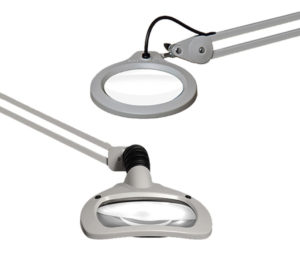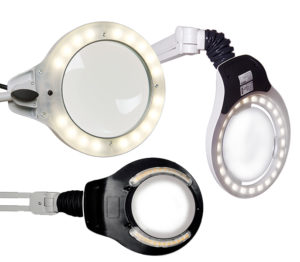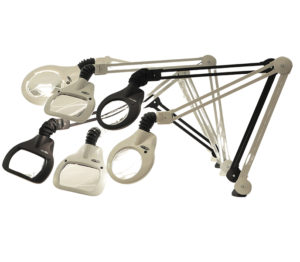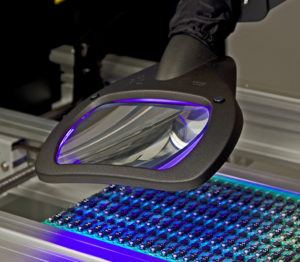Magnification equipment is essential for anyone working with precision assembly, inspection, or design. When looking for a tool that offers low magnification, bench magnifiers are the number one option. However, with so many bench magnifiers on the market to choose from, finding one that will suit your application and budget can be a daunting task. Below are some features that should be considered when choosing a bench magnifier.
Magnification vs Diopter
The reason why bench magnifiers are so popular is that it gives users increased magnification without needing to advance to using a stereo microscope. Magnification on bench magnifiers is expressed as “Diopter”. Diopter is a term used to identify the refractive capacity of a lens. Each diopter increases magnification by 25% above the original size. For example, a 4-diopter lens equals a 100% magnification increase above the original size. This can be confusing as many people are more familiar with using the term X (times) for magnification. It is easy to convert the diopter into magnification, simply divide the diopter by 4, and add 1. As an example 5.0 diopter = 5/4 + 1 = 2.25x.
Most bench magnifiers are available in 3.0, 3.5, and 5.0 diopter models, which equate to 1.75x, 1.88x, and 2.25x magnification. To increase magnification further, secondary lenses are available, which can increase magnification to 10 diopter (3.5x). It should be noted that increasing magnification will however reduce working distance and field of view.
Field of view, focal length, working distance, and depth of focus
The field of view is the area of the magnified subject that is in focus under the magnifier lens. Focal length and working distance refer to the distance from the center of the lens to the subject that is in focus. Depth of focus is the distance an object can be moved and remain in focus.
An important consideration is that as magnification increases the field of view, focal length/working distance decreases. Since bench magnifiers are designed for tasks requiring a low magnification, the typical focal length/working distance for 3D and 5D systems can range from 13” to 8”.
Round and Rectangular – what is the difference?
Bench magnifiers are available with both round and rectangular lenses. A rectangular lens has a larger field of view compared to a round lens. A round lens only has the center portion of the lens magnified undistorted and clearly in focus. Typically a 6” diameter round lens will have a 4” diameter field of view. A rectangular lens measuring 6.75” x 4.5” will have a field of view close to 6”.

Lens quality
For the best clarity and sharpness of an image without distortion look for bench magnifiers fitted with crown glass lenses. Crown glass offers superior resolution and image clarity. What are the benefits of crown glass? There are 2 types of glass used in optics, Crown glass and Flint glass. Crown glass is clearer due to its high Abbe value, which means there is less chromatic distortion, giving the user the best view possible. Bench magnifiers with glass lenses may last longer since it doesn’t scratch as easily as other materials. Crown glass is more expensive than other lens materials such as acrylic, yet they are more durable and therefore ideal for industrial environments.
Illumination
Proper lighting is equally important as magnification when it comes to attaining optimum viewing conditions. Many workplaces have indirect light or light that may create shadows on the subject. Illuminated bench magnifiers compensate for poor light conditions giving the user a better viewing experience. Finding illumination that will not alter the viewing color of the subject should be considered.
LED (light emitting diodes) have become the industry standard when it comes to illumination. They have an incredibly long life span (25 years under normal use) and offer excellent color rendition. Color rendition is measured by the Color Rendition Index (CRI). This ranges from 0-100 with 100 signifying the most exact, natural color. Bench magnifiers that have a CRI rating of 80 are considered excellent for accurate color rendering. Illumination is also measured by correlated color temperature (CCT). This is measured in Kelvin (K). The ideal illumination color for a bench magnifier measures between 4000K-5000K. This is considered natural white light which best replicates daylight.
The capability of dimming the light source and/or controllable light coming from either the left or right can be especially useful when working with circuit boards and similar delicate objects with 3D features.
Some applications require the use of UV light. These include inspection of conformal coated circuit boards, which is critical and should be carried out on completion of the coating process. Bench magnifiers with UV lighting provide inspectors and operators with an easy way to inspect conformal coated circuit boards.

Arm Construction and Movement
Arm construction should be considered when purchasing a bench magnifier since the arm supports the viewing lens or the head. The arm should be flexible, easy to maneuver, and once placed in the correct position stay in that position without drifting. There are 3 basic head movements the arm should support, horizontal, up and down, and rotation.
Look for arms with sturdy steel construction to eliminate shuddering during use. A spring-balanced arm provides maximum vertical and horizontal movement, and will always stay in the right position without drifting. The ability to do this without knobs to tighten or adjust makes the positioning of the magnifier effortless and ergonomic. And no knobs mean the magnifier can be placed in the correct position by using only one hand.

ESD Models
ESD (electrostatic discharge) is a discharge of static energy that emits heat, light, and sound. Electrical components, particularly microchips, are at the greatest risk of damage by ESD. The damage caused by EDS is only detected with the aid of a microscope. Therefore, it is essential that sensitive components are protected during the manufacturing, assembly, and shipping process. Special ESD equipment and tools deactivate the impact that static electricity has on these sensitive components. Many workstations can be fitted with antistatic desks, tools, gloves and clothing, grounding cords, and ESD rubber matting.
ESD bench magnifiers are available and ideal for use in these high-risk environments. ESD safe magnifiers are treated with a powder coating consisting of a metal laced paint that drains away static and distributes the static uniformly over the entire magnifier.

Warranty
Like all products, check the manufacturer’s warranty and the terms and conditions of the warranty.



